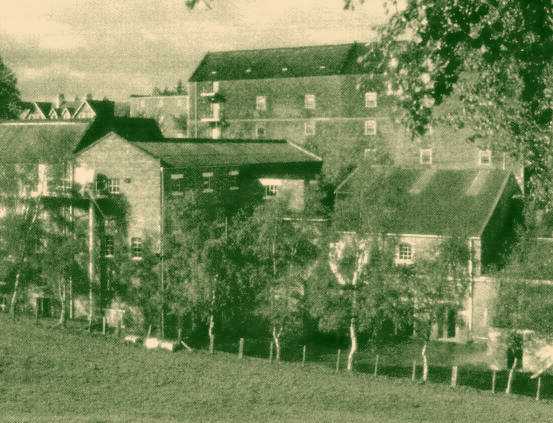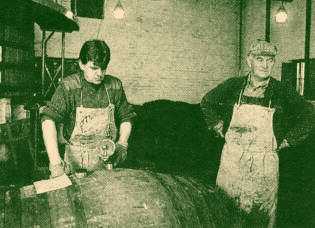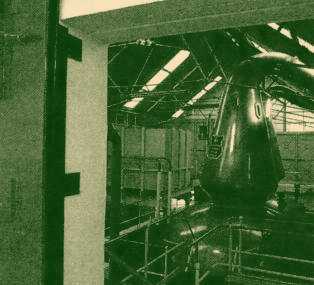

The red brick chimney is the give-away. A self-effacing sortof a chimney that protrudes from a hollow in the prosperous EastLothian countryside. A brickworks perhaps? A distillery would notbe your first thought. Unless, that is, you are one ofGlenkinchie's dedicated admirers, on a pilgrimage toPentcaitland.
This is not the rocky landscape of smuggler's caves and remotemountain passes, of rushing rivers running black with peat - allthat makes up the romance and the legend of uisge beatha.
Only 15 miles from the centre of Edinburgh, this is decent,well-tended farmland with neat hedges, neat houses and a few neatbank-balances. A bit short on magic and mystery, butrepresentative of virtuous men who knew what they were doing anddid it well.
This is the kingdom of Lot, brother-in-law of King Arthur,from whom Lothian takes its name. He held court on the summit ofTraprain Law, not far from Glenkinchie. The land here has beenunder plough for 2000 years and they grow some the best barley inBritain.
No less a countryman than Robert Burns described it as"the most glorious corn country I have ever seen". Noless a countryman than John Cockburn lived in the next village toPentcaitland. Known as the "Father of ScottishHusbandry", in the early 18th century he founded the Societyof Improvers of Knowledge of Agriculture.
This worthy title doesn't do justice to the revolutionarygenius of the man who introduced farming methods that put EastLothian ahead of the world. He also introduced the potato and theturnip to Scotland - thus inventing the Burns Supper!
It is impossible to be certain when whisky was first producedin East Lothian. The first written record is a royal command of1494 but by then the practice was already widespread. Distillingwas an intrinsic part of the farming cycle. An obvious means ofturning barley into cash. The spent grain was then used to fattencattle.
However, after the Union of Scotland and England the tax onwhisky, which had existed more or less theoretically since 1655,was now enforced. Not only were the excise men demanding duty onsomething the farmers saw as being as natural as the seasonsthemselves, but they were doing it in the name of England! Battlewas joined.
Illicit distilling in the Lothians went on its merry way.Seventy years after the implementation of the tax, in 1777, therewere only eight licensed stills in nearby Edinburgh. Four hundredillicit ones were discovered.
 In 1837, a licence to operate adistillery at Glenkinchie was granted to pair of local farmers,the brothers George and John Rate. They are known to have owned adistillery in the area called Milton from 1825 and it seemslikely that Glenkinchie was the same business trading under a newname.
In 1837, a licence to operate adistillery at Glenkinchie was granted to pair of local farmers,the brothers George and John Rate. They are known to have owned adistillery in the area called Milton from 1825 and it seemslikely that Glenkinchie was the same business trading under a newname.
Glenkinchie was a model of self-sufficiency. The brothers grewthe barley and malted it. They drew water from the Kinchie Burn(Kinchie is a corruption of the Norman name de Quincey, a familywhich once owned the surrounding land) and mashed it to make maltwhisky. Cattle and horses flourished on the "draff".
This relationship between the distillery and the land atGlenkinchie has remained unbroken, although nowadays it hangs onby a thread. The 85-acre farm is still there but leased out,although for many years a distillery manager, W J McPherson,farmed the land himself, making Glenkinchie famous for itsAberdeen Angus cattle.
The mighty Clydesdales have gone but Hector MacDonald, one ofthe still operators, worked the horses as a boy as did hisbrother and their father before them. The dray horses' job was tocart the whisky casks to Saltoun railway station about a mileaway, rattling over the little stone hump-back bridge which isstill a prominent feature. They would come back loaded withbarley or coal for the furnaces. The drays that Mr MacDonaldthought to have a suitable temperament for city life went away toGlasgow, to Buchanan's bonded warehouses. But they came back tothe green fields of Glenkinchie for their summer holidays.
The casks go out by lorry now, to mature in a huge moderncomplex in Alloa. The three Glenkinchie warehouses are full. Themalt comes in by lorry, from Roseisle in Morayshire, alreadyprepared to the distillery's lightly peated "recipe".
Hector MacDonald (a stillman who's never touched a drop ofwhisky in his life) remembers taking a tin mug to school with himto scoop up the pure malt from the malt house floor ... he smiledcontentedly at the memory. The maltings closed in 1968 and themalting floor was converted into museum - the only museum of maltwhisky production in the world and the brainchild of the thenmanager, Alistair Munro.
The closure of the maltings floor brought home to him howrapidly the industry was changing and he determined to record thememories and the machinery. This year should see the opening ofan important new visitors' centre.
The whole feel of Glenkinchie is very Victorian. In 1890 theEdinburgh consortium who took it over from the Rate brotherscompletely restructured the distillery and gave it the"Bourneville" treatment, building a small village ofhouses for the workers and supplying them with fresh food fromthe farm. Later, in the 1920s, the workers laid out a bowlinggreen which is still well tended. Only a handful of the cottagesremain in the distillery's ownership, although some familiesbought theirs and still live there.
 In 1972 the still house was rebuilt andthe stills were converted to internal coil heating. In 1995 a newmash house was built. But it has all been done with care and agentle touch. The six wooden washbacks remain: two made fromOregon pine and four from Canadian larch. There are two copperpot stills for distillations and the wash still, with itscapacity of 32,000 litres, is one of the largest in the industry.It shares with the spirit still a traditional worm condenser,coiled two stories high.
In 1972 the still house was rebuilt andthe stills were converted to internal coil heating. In 1995 a newmash house was built. But it has all been done with care and agentle touch. The six wooden washbacks remain: two made fromOregon pine and four from Canadian larch. There are two copperpot stills for distillations and the wash still, with itscapacity of 32,000 litres, is one of the largest in the industry.It shares with the spirit still a traditional worm condenser,coiled two stories high.
One thing is constant: the water that is drawn from theKinchie Burn. Diamond bright and diamond hard, it rises in theLammermuir Hills, running over rich limestone deposits. And thechalk makes Glenkinchie the driest of all the Lowland malts.
It is this water and the climate - sunnier and drier than theHighlands - which gives Glenkinchie and the other Lowlanderstheir quite distinct character. Lighter and drier than theirHighland and Island cousins, the soft sweetness of the malt isallowed to come through.
This very versatile style of whisky appeals to the Lowlandpalate and makes it beloved of the blenders. (Glenkinchie is acomponent of - among others- Haig Dimple). By the 1890s blendedwhisky was being sold in 120 countries, with Edinburgh and itsPort of Leith at the hub of the trade.
As Edinburgh prospered and grew, so did the distillery atGlenkinchie, but now in the ownership of an Edinburgh consortiumof brewers and wine merchants. In 1914 the company theyestablished was one of five Lowland malt whisky distilleries toform Scottish Malt Distillers, now part of United Distilleries.
Now this soft, restrained whisky takes its place as theLowlands representative in the United Distillers' Classic Maltsrange, marketed as "The Edinburgh Malt." Its outputcurrently runs at full capacity and the opening of the newvisitors' centre later this year is expected to draw in about60,000 visitors per annum once it is up and running. This modestlittle distillery must be blushing red to its Victorian brick.
Gillian Strickland
If you have comments about thissite, please contact the